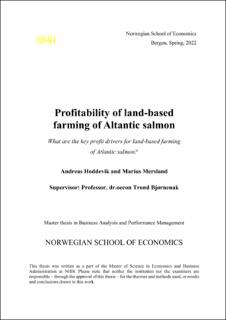| dc.description.abstract | Several factors suggest that global production of seafood will have to increase in the future
from a demand perspective. In principle, this growth must come from aquaculture as global
fisheries are to a large extent fully exploited. However, the growth potential of aquaculture in
the sea is limited due to environmental and biological issues. As a consequence, this master
thesis attempts to answer the following problem statement:
What are the key profit drivers for land-based farming of Atlantic salmon?
A conceptual theoretical framework for the relation between strategic decisions and profit
drivers is established based on the theory and perspectives about strategic management
accounting. In light of this framework, a comprehensive literature review on the profitability
of land-based salmon farming is performed. Unfortunately, most of the reviewed literature
lacks a systematic discussion of the key strategical choices for the industry’s profitability. The
previous literature concentrates solely on the profitability of imaginary and fictional RAS
facilities, disregarding the profitability of the other two technology types.
For this reason, we have further divided the problem statement into three research questions
to examine what strategic choices are the most important in the emerging industry, and how
these choices drive costs and revenues, respectively. In connection, we perform a case study
of three existing land-based farming facilities soon producing on land in Norway and Japan.
Our selection represents the three main technology types one can utilise in the industry.
An important implication of our analysis is that we find that land-based salmon farming is not
just a cost game regarding competitive strategy. There is also a differentiating potential,
particularly if product quality is related to the branding of animal welfare and sustainability in
the marketing, which could result in a price premium for land-based salmon.
However, our main finding is that the examined industry is very complex with respect to
business strategy. Strategic choices such as technology and location influence each other and
could drive both capital expenditures and operational costs. At the same time, these choices
impact subsequential operational choices like facility layout and capacity utilisation, which all
drive costs. Moreover, we argue that some economies of scale and scope exist in land-based
salmon farming. However, quality management and strategic partnerships are considered more
important for the profitability as the production methods are not plug-and-play. Considering
that our conclusion is based on uncertain company estimates, further research should strive to
validate our conclusion with reliable data when the industry is more mature. | en_US |

